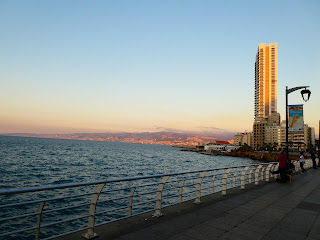During the two days
that we were in the Baalbek area, we visited 3 ancient quarries. Limestone was what
was being removed here, not only by the ancient inhabitants going back who
knows how far, but also by the Romans.
Our first stop upon
getting into the area was at the quarry where the “Stone of the Pregnant Woman”
was located. Mythology states that if a
woman touched the stone, it would enable her to become pregnant. It must have been quite a pilgrimage site. It’s a good thing that the women in our group
were past childbearing age, or we could be in trouble! By best estimates, this accurately cut stone
weighs 1000 tons. Yes, tons! Above is a photo of the group standing
next to it for perspective.
The largest
foundation blocks that we saw at Baalbek were estimated to weigh 800 tons, and no one
knows how they were moved and put into place.
This one is more massive than those. You
can see where the level of the surface soil was until it was removed.
In the process of
excavating, another massive stone was uncovered below and next to the first
one. Its weight is estimated at 1650
Tons. It is possible that there may be
more here further below these.
The question is, who
quarried these stones, how were they going to remove them, and where were they
going to go? From his experience with
quarries around the world, Hugh Newman has a theory that one massive and
possibly unmovable stone is always left in the quarry.
Why, who knows! Certainly we saw that at Karahan Tepe, and it is also
true at the red granite quarry in Aswan, Egypt, with the unfinished obelisk
that is larger than anything else found in that country.
Our next stop was
the quarry across the road. Here we have
another cut stone weighing over 1200 tons.
Slices and chunks have been taken out of it presumably for other
building projects. BTW, it was at this
point when the big wind and rain storm blew in.
The last stop after
our day at Baalbek was to a quarry in a residential neighborhood that was
rarely visited by tourists. It was a
hidden gem! We first visited a cave that was dug into the ground by the Romans.
The purpose of this was to get to the best quality of limestone.
Note the outlines of
the chunks of stone that had been removed by the Romans
To me, that does not match up with the massive stone foundations that we had seen at Baalbek. I am convinced
that those were there before the Romans arrived on the scene.
Now we went cross the field to what I
have dubbed “The Sun Temple”.
Certainly the rock on
this outcropping had been carved, but not necessarily to remove it as building
material. Here is a very fancy cave that
had been carved. Note the vertical grooves
at the back, and the light coming in through a square opening on the left side,
illuminating a pattern on the grooves.
Of course, we were there at the wrong time of
year to see either solstice or equinox sunrise or sunset phenomena, but I am
convinced that that was the purpose of this site. Every ancient agricultural society had to
keep track of the seasons in this way.
Also note the “stairway” to nowhere that was to the left of this cave.
This is a common sight in Peru, and I also
noticed at least one of these at Hattusa.
Around the corner and
further to the left on the same outcropping was another carved cave. It was oriented to the west, and the setting
sun was shining into it. Here is a photo
of it with a shadow, and then one without the shadow cast by the sun.
Again, one would have to be here during those
sun calendar events to see exactly what was going on. It looked like a winter solstice shrine, and the exact date of the solstice would be determined by where the shadow lined up with the appropriate carved "step".



































